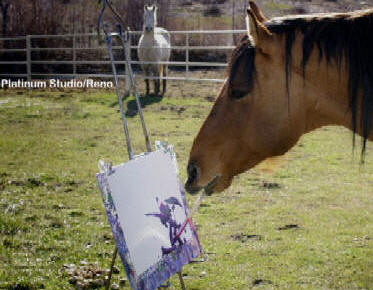By Steve Aishman
A collection of art news from around the globe over the past few years:
1. In 2008, Paul McCarthy's "Complex Shit", a giant inflatable dog turd, broke free, destroyed some power lines, and then crashed into a children's home in Switzerland.

2. In January of 2009, a tattoo artist found a way to tattoo the white part of your eyes. State senators in Oklahoma have already pre-emptively banned the practice.
3. Since I'm writing about eyeballs, artist Xiang Chen paints by holding the brush with his eyeball.

4. In July of 2007, a woman was arrested for kissing a Cy Twombly painting that was worth about $2 million.

The 3x2m (9x6-foot) painting by US artist Cy Twombly is valued at more than $2m (£970,000).
5. In fashion news in 2008, a Swedish clothing company started making two-piece bikinis for girls as young as 2 months old.

6. In 2008, a horse named Cholla entered one of her paintings into a juried exhibition for a galley in Venice and was accepted without the judges knowing she was a horse. Cholla will have her work exhibited at Gallery Giudecca 795 in Venice, Italy in May of this year.

Cholla painting
But for me, the weirdest thing I have heard about this year is that Salander-O'Reilly Galleries was using art as the central commodity in their $88 million Ponzi scheme. Apparently, people like John McEnroe would give Lawrence Salander money to buy art for them and then immediately re-sell it at a higher price. While I realize that art is a commodity that functions in the capital market like most other commodities, art just does not seem like the best choice of commodity to use for a Ponzi scheme. The main reason why it does not seem like the best choice is that art is not a very liquid asset and Ponzi schemes usually thrive on short-term profits that usually need a fast turnaround. Also, most of the pieces of artwork he was using in his Ponzi scheme were unique pieces of physical art, but he was able to sell the same paintings to multiple people. I honestly had no idea that people bought and sold art so quickly that it was possible for the art dealer to actually sell the same painting to two people and neither of them know about it! Apparently, Salander also regularly sold artwork that did not belong to him. I assumed that when someone bought a piece of art at some point they would actually take possession of the art, put it somewhere and look at it. But obviously I'm wrong because none of his clients seemed to catch on even after he would "sell" them a painting for a few million dollars and then "sell" the same painting to someone else and then never deliver the painting to either person. As an artist, this use of art as a Ponzi scheme commodity is truly fascinating and clearly highlights how much weirder the world of art is than I could have ever expected.

Gorky's "Pirate I" which Salander allegedly sold to multiple people.



